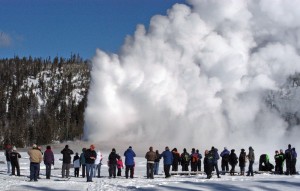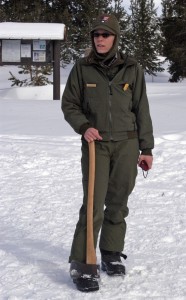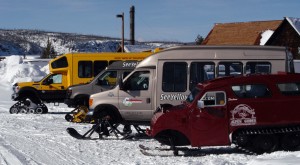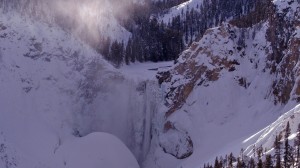
By Ruffin Prevost
YELLOWSTONE NATIONAL PARK — Even before snowmobile guide Terry Dolan enters Yellowstone National Park, he is standing on his sled’s running boards, craning his neck to catch a glimpse of the river below.
Just outside the East Gate, Dolan spots three moose along the bank of the North Fork of the Shoshone River. Their dark, oily coats stand out against the snow, and two of them appear to sparring — rearing up on their hind legs and swatting at each other with their front legs.

“Well, I’ve never seen that before,” one rider muses.
“That’s what keeps this job fresh and interesting. It’s something different every time you come in the park,” Dolan says.
Dolan guides snowmobile trips for Wapiti-based Gary Fales Outfitting, the only winter tour business permitted to operate through the park’s East Gate. He took three reporters through the park in January, making the entire lower-loop trip in a day-long excursion that began right after sunrise and ended just past sunset.
The uncertain politics of winter use in Yellowstone over the last decade have made it tough for tour guides to operate profitably, but especially difficult for a guide booking trips over Sylvan Pass.
The 8,524-foot mountain pass between the East Gate and Fishing Bridge lies beneath several avalanche chutes, and is sometimes closed by rangers if they decide conditions are unsafe for visitors.
But Dolan said good cooperation and communication with the current crew of National Park Service avalanche forecasters has made his job more predictable, and he is anxious to show off a unique and adventurous route through the park that few visitors get to see in the winter.

“We may be the only ones in the park today who will do the whole (lower) loop,” Dolan tells his group.
Many winter day-trippers into Yellowstone make a beeline for Old Faithful, watch the famous geyser erupt, grab a quick lunch and stop by the gift shop before returning by the same route. Dolan’s tour covers more than 150 miles and takes in the major sights along the lower section of the park’s Grand Loop Road, including Yellowstone Lake, Old Faithful, Fountain Paint Pot and the Lower Falls of the Grand Canyon of the Yellowstone River.
Call of the wild
Ranger Dennis Lenzendorf greets Dolan at the East Gate and shares a quick story of spotting — and hearing — a group of wolves on a recent snowmobile ride.
“The sound of wolves howling in the valley is spectacular,” Lenzendorf says.
Near Steamboat Point, Dolan again stands on his running boards and spots a sight worth stopping for.

A coyote is hanging out on a frozen section of Yellowstone Lake, just below an overlook. Dolan reckons the coyote may be shadowing otters, waiting to pick up fish scraps — or even steal an entire meal. The otters are adept at hauling fat trout out of the lake at spots where thermal vents pump out warm water, keeping small sections free of ice.
At Fishing Bridge, a group of trumpeter swans cruise the shoreline in the distance.
The birds prefer to feed in slow, shallow water, eating aquatic vegetation.
Named for its trumpet-like call, most of the swans that winter in Yellowstone are from Alberta, Canada. The largest native North American species of waterfowl, trumpeter swans are about four feet high, but can measure six feet from bill to feet if fully outstretched.
They weigh 20-30 pounds, have wingspans of 6-8 feet and can live in the wild for nearly three decades, although about 20 years is typical.

At West Thumb, Dolan stops briefly at a warming hut to ask a ranger when the next eruption of Old Faithful is expected. The geyser erupts with predictable regularity, typically about every 90 minutes. With most buildings in Yellowstone shuttered for winter, warming huts at a few developed areas across the park offer travelers a place to get warm, dry out and take a break by a crackling fire.
Dolan brings his “dudes,” as he calls his tour clients, into Old Faithful just before the geyser erupts, a lucky bit of timing that will ease the tight schedule he follows on such trips.
Making a loop through Yellowstone in the summer can be challenging enough. But doing it on snowmobiles at a top speed of 45 mph — and a practical speed of much less when the snow is choppy — is not an adventure for the faint-hearted.
Gusting winds and blowing snow will find a way through the smallest gap in clothing, while the sometimes bumpy and always brisk ride might not suit visitors seeking more comfort and security.
But for adventurous travelers, the trip offers an exhilarating and often thrilling way to tour the park, with a small group of good riders able to quickly stop and hop off their sleds for photos or sightseeing before pushing on to the next landmark.
Divided opinion
Many individuals and advocacy groups, including the Greater Yellowstone Coalition, are opposed to allowing any snowmobiles in the park, saying the machines are dirty, noisy and a poor match for the tranquil winter atmosphere in Yellowstone.
Paul Heil of Minnesota was visiting Old Faithful in January on a day trip by snow coach from West Yellowstone. Heil has also toured the park by snowmobile, but prefers to ride snowmobiles in areas where he can travel off-road and in deeper powder.
“I’m not necessarily a tree-hugger, but there’s no reason to ride a snowmobile if you can’t go anywhere off the road,” Heil said.
Yellowstone regulations require snowmobiles and snow coaches — both of which can only enter as part of permitted, commercially guided tours — to travel only on groomed trails that follow the park’s main paved roads.
Huguette Bradley was visiting from Ontario, Canada and traveling with Heil.

Bradley said she prefers the relative warmth and fellowship of a snow coach, and that she was amazed by the contrasts between seasons in Yellowstone.
“The trees are crystallized. Oh, my gosh, I was in awe,” she said.
“The winter is so much different than the summer,” Heil said. “In the snow, the geysers are just accentuated by the cold, and they’re twice as beautiful. It’s unbelievable.”
Dolan moves his group on to the Lower Geyser Basin, where he discusses the park’s unique geology, pointing out how thermal features have changed during just the relatively brief period of years when he has been visiting the park.
For those winter visitors who have time, Dolan advises that they spend four or five days around the Cody area. That offers them a better chance of favorable weather and open travel over Sylvan Pass, as well as an opportunity to ski or snowboard at nearby Sleeping Giant, a community-owned ski hill about five miles from the East Gate.
But many visitors simply call up when they get to town, Dolan said.
“A lot of people come to Cody, Wyoming to see Yellowstone National Park in the winter,” he said. “And some of them just book when they get here.”

Some customers, like a group of fathers and sons from Australia, come year after year, he said. The Australian group of about a dozen riders last booked a two-night trip from Cody with stays at Chico Hot Springs (catching a shuttle from Mammoth) and West Yellowstone.
“It’s a great way to see a lot of the park in the winter,” he said.
Dolan typically charges $350 per sled, whether one person or two rides, and he has only three sleds available this year, down from previous seasons.
He’s hoping the politics of winter use will get sorted out by next winter, and that a viable, long-term plan will include a place for snowmobilers in the park.
“I think the perception will change if people know they can count on something from year-to-year,” Dolan said of declining snowmobile numbers in recent years, particularly through the east entrance.
Frozen flow
Dolan leads his dudes on again, stopping this time to view the Lower Falls in the Grand Canyon of the Yellowstone River. A thick blanket of snow clings at odd angles to the canyon walls, offering stark contrasts with the brown and copper striations stacked down to the water below. The falls are clouded in mist, but great portions of the vast, tumbling, churning spectacle are frozen solid in defiance of the inexorable flow so familiar from summer viewings.

As the tour draws to a close, so does the day, with the sun setting above the far shore of Yellowstone Lake. Dolan guides his dudes up to Lake Butte Overlook, atop a one-mile spur off the east entrance road, between Fishing Bridge and Sylvan Pass.
The view is spectacular, with the frozen lake reflecting the red and orange hues of the setting sun as it hangs below the clouds, but above the ice.
Dolan points out the Tetons, just visible in the far distance. The overlook offers a sweeping survey of the lake and southern Yellowstone backcountry that includes an area that is the most distant from any paved road in the 48 contiguous states.
From Lake Butte Overlook, it’s about a 30-minute ride back over Sylvan Pass and out of Yellowstone, back to a world far-removed from trumpeter swans and 40-mile views, sneaky coyotes and erupting geysers, bubbling mud pots and frozen waterfalls.
But that world — the wonderland that is Yellowstone in winter — is always waiting for a return visit, and never lies more than half a year away.
Contact Ruffin Prevost at 307-213-9818 or [email protected].

Loved this article! Makes me want to get on a snowmobile. I did that in Teton Nat. Forest on groomed trails and loved it! We saw moose and elk. Stay warm!
Wonderful article! I wanna visit this place!!
Thanks, Ruffin!